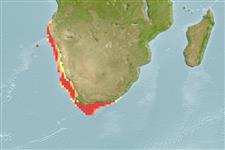Élasmobranches (requins et raies) (sharks and rays) >
Carcharhiniformes (Ground sharks) >
Scyliorhinidae (Cat sharks) > Scyliorhininae
Etymology: Scyliorhinus: skylion, Greek for dogfish or small shark; rhinus, from rhine (Gr.), rasp, alluding to a shark’s jagged, rasp-like skin (See ETYFish); capensis: -ensis, Latin suffix denoting place: Cape of Good Hope, South Africa, type locality (See ETYFish).
More on authors: Müller & Henle.
Environment: milieu / climate zone / depth range / distribution range
Écologie
marin démersal; profondeur 26 - 495 m (Ref. 5578). Subtropical; 0°S - 37°S, 0°W - 29°E (Ref. 57015)
Southeast Atlantic: Lüderitz, Namibia to central Natal, South Africa.
Length at first maturity / Taille / Poids / Âge
Maturity: Lm 69.0, range 68 - 70 cm
Max length : 122 cm TL mâle / non sexé; (Ref. 244)
Description synthétique
Clés d'identification | Morphologie | Morphométrie
Épines dorsales (Total) : 0; Épines anales: 0. Bright yellow or golden spots on a dark grey body with irregular blotches and saddles (Ref. 5578), cream below (Ref. 5510); 2nd dorsal much smaller than 1st (Ref. 5578). Small anterior nasal flaps that do not reach mouth, no nasoral grooves (Ref. 244).
A common inshore to offshore catshark. Prefers to feed on small bony fishes and crustaceans, also cephalopods (Ref. 244). Oviparous (Ref. 50449).
Oviparous, with a single egg per oviduct at a time (Ref. 244). Oviparous, paired eggs are laid. Embryos feed solely on yolk (Ref. 50449). Size upon hatching below 31 cm (size of young with umbilical scars) (Ref. 244).
Compagno, L.J.V., 1984. FAO Species Catalogue. Vol. 4. Sharks of the world. An annotated and illustrated catalogue of shark species known to date. Part 2 - Carcharhiniformes. FAO Fish. Synop. 125(4/2):251-655. Rome: FAO. (Ref. 244)
Statut dans la liste rouge de l'IUCN (Ref. 130435: Version 2024-1)
Menace pour l'homme
Harmless
Utilisations par l'homme
Pêcheries: sans intérêt; pêche sportive: oui
Outils
Articles particuliers
Télécharger en XML
Sources Internet
Estimates based on models
Preferred temperature (Ref.
123201): 9.3 - 16.5, mean 12.2 °C (based on 45 cells).
Phylogenetic diversity index (Ref.
82804): PD
50 = 0.5000 [Uniqueness, from 0.5 = low to 2.0 = high].
Bayesian length-weight: a=0.00263 (0.00138 - 0.00502), b=3.21 (3.04 - 3.38), in cm total length, based on LWR estimates for this (Sub)family-body shape (Ref.
93245).
Niveau trophique (Ref.
69278): 4.0 ±0.5 se; based on diet studies.
Résilience (Ref.
120179): Très faible, temps minimum de doublement de population supérieur à 14 ans (Fec = 1).
Fishing Vulnerability (Ref.
59153): High to very high vulnerability (73 of 100).
